Abstract
This article addresses the issue of energy waste resulting from frequent braking of underground mine cars and proposes an optimization design to address this. The proposed solution involves the installation of a regenerative braking device within the mine cars to capture and reuse the energy wasted during braking. This implementation improves the endurance capabilities of the underground mine cars. The article begins by analyzing the working characteristics of underground mine cars and proposing a design optimization method based on regenerative braking energy. Subsequently, a regenerative braking device specifically designed for underground mine cars is introduced. Finally, through physical modeling, a comparison is made between the energy consumption of the underground mine cars before and after the installation of the energy recovery system, allowing for an estimation of the actual benefits of energy recovery. The results demonstrate that the regenerative braking system successfully recovers approximately 60% of the braking energy during operation, resulting in an improvement of around 20% in the endurance capabilities of the underground mine cars. This significant enhancement contributes to the improved energy utilization efficiency of coal mine electric cars, reducing system energy consumption and lowering CO2 emissions.
1. Introduction
Coal mining is a crucial industry in China, with more than 90% of coal production occurring underground. Consequently, the use of underground mine cars is widespread, driven by various factors [1,2]. One significant advantage of underground mine cars is their ability to transport materials within mining sites. These mine cars facilitate the quick and efficient transportation of essential mineral products such as ore, coal, and slag, resulting in time and labor savings. Another benefit is that underground mine cars enable the continuous transportation of large-scale ore, enhancing production efficiency. By utilizing automatic or semi-automatic systems, mine cars can transport ore continuously on the mining face, thereby reducing manual labor, labor intensity, and production time. Additionally, the use of underground mine cars allows for the transportation of miners, thereby reducing the time required for miners to reach their workface. This not only improves production efficiency but also minimizes the time spent by miners in hazardous underground environments, consequently reducing the risk of accidents. Furthermore, underground mine cars contribute to mitigating the adverse environmental impacts of underground mining. With reduced mechanical excavation and ore processing activities, emissions of noise, vibration, and dust are decreased, thereby protecting surrounding ecosystems and minimizing surface environmental damage caused by mines [3]. Clearly, underground mine cars play a crucial role in mining operations. They enhance production efficiency, ensure miner safety, optimize resource management, and diminish adverse environmental impacts. Consequently, they have become an indispensable tool in modern underground mining practices [4,5].
There is currently a significant issue of energy waste during the traction process of underground mine cars. Given the unique characteristics of underground coal mining environments, these mine cars frequently operate on uphill and downhill sections. Unfortunately, during the downhill process, the mine cars generate a substantial amount of potential energy that is dissipated as inertial energy consumption during braking. Presently, this energy is primarily wasted in the form of heat, resulting in a notable electricity waste. Not only does this lead to the squandering of energy resources, but it also increases coal mining production costs.
Currently, there is limited research on the optimization and improvement of underground mine cars conducted by scholars worldwide. Most studies have focused on track stability and mine car maintenance effectiveness. For instance, Chao Hong investigated the external causes of mine car transport damage, such as track damage and vehicle vibration. Using computer simulation technology, they simulated the effects of wheel-rail interaction forces on the pitching and vertical vibration of mine cars during underground transport. They identified internal factors influencing smooth operation and proposed a control strategy involving the installation of metal rubber [6]. Similarly, Hongliang He. aimed to enhance the maintenance efficiency of underground mine cars and improve overall coal mining safety. Through the implementation of various management measures to enhance maintenance effectiveness, they analyzed maintenance methods for underground mine cars and how to promote maintenance efficiency [7]. Lastly, Haijian Zuo focused on ensuring the safe and smooth operation of underground electric locomotives in coal mines to avoid derailment. Drawing on practical experience, they discussed the design and application of automatic re-railers for underground mine cars, offering rational suggestions [8]. However, these existing studies mainly revolve around maintenance efficiency and track stability, resulting in only marginal improvements in the working efficiency of mine cars as they do not involve designing and optimizing their structure.
In contrast, significant advancements have been made in energy recovery technologies for electric vehicles globally. For instance, Honda’s electric car “Insight” features a regenerative braking system based on an ISG motor and hydraulic system. By combining this system with throttle control methods, they developed a control strategy for the braking force distribution coefficient, achieving efficient operation of the regenerative braking system. Similarly, Ford’s fuel cell car “Focus” is equipped with a regenerative braking system that enables the vehicle to achieve a range of 160–200 miles. Additionally, the HILS system developed by Chungham National University in South Korea is specifically designed for the braking force distribution system of hybrid vehicles. These examples illustrate that regenerative braking systems can significantly increase a vehicle’s driving range. Therefore, it is feasible to install regenerative braking systems on electric mine cars to achieve energy conservation and emission reduction goals [9,10,11,12].
To improve the working efficiency and range of underground mine cars, this paper suggests installing a regenerative braking device on the traction motor car. This device efficiently converts the generated potential energy during downhill travel and the energy produced during braking into electrical energy, which is then stored in a battery. The stored energy can subsequently power the motor car, enhancing its range. Moreover, the regenerative braking device can assist the vehicle during acceleration, further improving its range. Additionally, this device can contribute to braking by reducing wear on the vehicle’s braking system.
2. Design of Regenerative Braking System for Underground Mining Vehicles
This study specifically examines the energy consumption analysis and regenerative braking design of the CTY5/6GB explosion-proof electric motor car manufactured by the Xiangtan Yutong Company, as depicted in Figure 1. This motor car features an optimal overall structure, dependable explosion-proof performance, high efficiency and energy-saving capabilities, and a significant starting torque, guaranteeing stable operation. It is equipped with various protective devices, requires minimal maintenance, and provides the option of mechanical braking, regenerative braking, and hydraulic braking, thereby enhancing the vehicle’s safety and reliability.
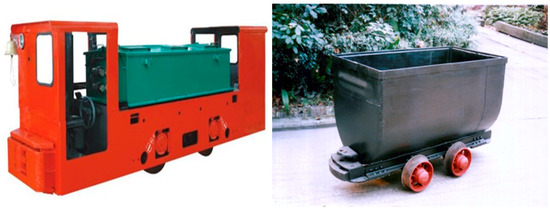
Figure 1.
Mining locomotive and mining vehicles.
Regenerative braking operates by harnessing the reversible principle of the electric motor/generator. Its fundamental principle is as follows: due to inertia, the rotational speed of the wheels transmitted to the motor rotor through the reducer exceeds the motor’s synchronous speed. Consequently, the rotor cuts the magnetic flux lines in the opposite direction, generating a reverse electromotive force greater than that of the stator coil. This causes the driving motor to enter the energy recovery mode, and the traction motor exerts a reverse force on the driving axle, creating a regenerative braking force on the wheels [13,14]. However, it is important to note that while regenerative braking can recover braking energy and provide partial braking force to the wheels, it cannot completely halt wheel rotation. The effectiveness of regenerative braking is influenced by various factors, including the motor, battery, and speed. In instances of emergency braking or high-intensity braking, regenerative braking alone may not fulfill the braking requirements. Therefore, to ensure the braking safety of the mine car, the use of motor regenerative braking must be supplemented with the locomotive’s own braking system. This approach ensures both the braking safety of the mine car and the recovery of a substantial amount of energy [15].
2.1. Selection of a Regenerative Braking System
Currently, regenerative braking systems are classified into two types based on the decoupling of the brake pedal force and hydraulic braking force: additive regenerative braking system (RBS) and cooperative regenerative braking system (CRBS). To determine the most efficient and concise system for energy recovery, a comparison between these two regenerative braking systems is conducted [16].
In the additive regenerative braking system (RBS), the brake pedal force and the hydraulic pressure in the brake wheel cylinder are not decoupled. As shown in Figure 2, when the brake pedal is pressed during the braking process, the brake wheel cylinder generates hydraulic braking force, with the motor braking being simply added to supplement this force. Consequently, there is still some energy loss, resulting in a lower energy recovery rate [17,18,19].

Figure 2.
Non-decoupling of brake pedal force and hydraulic brake force.
In the cooperative regenerative braking system (CRBS), the brake pedal force and the hydraulic pressure in the brake wheel cylinder are decoupled. As illustrated in Figure 3, when the brake pedal is depressed, the controller gathers information on the current brake pedal position and the rate at which it is changing to identify the driver’s braking demand. It then calculates the necessary braking force. In this system, the motor braking force serves as the primary source of braking, while the hydraulic braking force acts as a supplementary component. Both forces are dynamically coordinated and controlled to maximize the proportion of motor braking and optimize energy recovery.

Figure 3.
Decoupling of brake pedal force and hydraulic brake force.
The main distinction between the two systems is whether the brake pedal is decoupled from the brake actuator. In the braking scenario of an electric vehicle, the braking torque is derived from two sources: hydraulic braking generated by the brake wheel cylinder, and regenerative braking provided by the motor through the drive shaft [20,21]. In Figure 4, when the brake pedal and brake actuator are not decoupled, regenerative braking is applied in addition to hydraulic braking during light braking. However, due to limitations, regenerative braking results in some energy loss and incomplete energy recovery. Conversely, when the brake pedal and brake actuator are decoupled, regenerative braking is initially employed during the braking process. If the required braking force exceeds the regenerative braking force (F1) of the motor, hydraulic braking is then utilized as auxiliary braking. This enables regenerative braking to be present throughout the entire braking process, maximizing the recovery of braking energy.
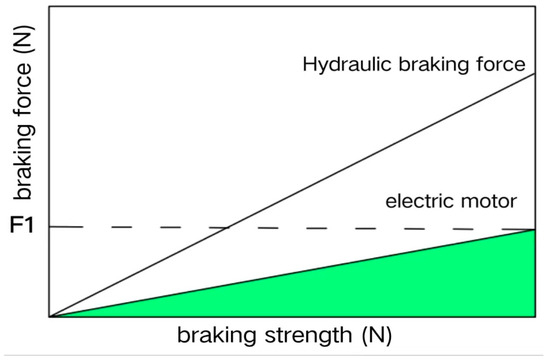
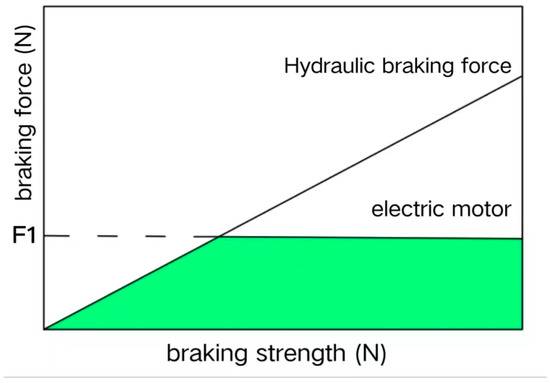
Figure 4.
Relationship between braking force and braking intensity in the series regenerative braking system and the cooperative regenerative braking system.
Based on the comparison presented in Table 1, the decision is made to install the cooperative regenerative braking system on underground mining vehicles. This choice is driven by the goal of fully recovering wasted energy during the braking process, maximizing the endurance of these vehicles, and improving the efficiency of underground operations. By implementing the cooperative regenerative braking system, the desired objectives can be achieved.

Table 1.
Comparison of two regenerative braking systems.
2.2. Methods of Energy Storage for Mining Vehicles
This study focuses on the CTY5/6GB explosion-proof electric locomotive, which has replaced the conventional overhead power supply with maintenance-free lead-acid batteries. These batteries possess strong explosion-proof properties and do not require electrolyte maintenance. They can be charged directly, resulting in low maintenance costs. In this locomotive, the battery is integrated with the regenerative braking system, serving as the energy storage component for energy recovery. The motor functions as the energy conversion component. During the braking process, the vehicle controller disconnects the connection between the engine and transmission. Consequently, the kinetic energy of the locomotive drives the transmission mechanism, causing the motor to rotate. As demonstrated in Figure 5, this conversion process transforms kinetic energy into electric energy, which is then stored in the battery, thereby increasing its capacity. The motor supplies power to the locomotive during acceleration or climbing phases.

Figure 5.
Principle of the battery energy storage system.
2.3. Coupling Design of Regenerative Braking System for Underground Mining Vehicles
This study focuses on the CTY5/6GB explosion-proof electric locomotive manufactured by the Xiangtan Yutong Company. A model of the cooperative regenerative braking system is developed, with the battery serving as the energy storage component and integrated with the vehicle’s auxiliary system. The system layout is depicted in Figure 6. In this system, the electric motor supplies power to the traction locomotive through the drive shaft. During vehicle startup, the battery provides power to the electric motor, ensuring quick and efficient acceleration. During braking, the electric motor transitions into a generator state, recuperating energy generated by the braking process and storing it in the battery. This feature enables energy recovery and storage, effectively enhancing the locomotive’s energy efficiency. Furthermore, in situations such as long downhill slopes where forced braking is not required, the electric motor operates in generator mode. This allows the conversion of the vehicle’s inertia energy into electricity, which is then stored in the battery. This approach not only reduces energy consumption but also prolongs the battery’s lifespan.
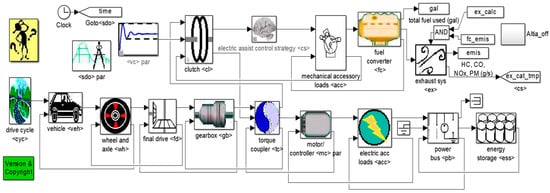
Figure 6.
Internal structure of the regenerative braking system.
3. Analysis of Energy Consumption after Installing the Regenerative Braking Energy Recovery System
To comprehensively assess the energy recovery efficiency of installing the regenerative braking system on underground mining vehicles, a continuous road condition was designed and simulated in this study. The aim was to replicate various scenarios encountered during actual underground operations, ensuring a more precise estimation of the energy recovery performance. The simulation began with the mining vehicle starting from the beginning point and traveling at a constant speed on a level track. This stage simulated the initial phase of the vehicle’s journey from the working face to the transportation exit. The road segment designed for this phase featured a level slope, allowing the mining vehicle to maintain a stable speed in the initial state. Next, the road gradually transitioned to an uphill slope with a gradient of 5°, incorporating curved sections to mimic the bends in actual underground mine tunnels. This segment of the road examined the braking system’s performance during uphill and turning conditions, as well as the efficiency of the energy recovery system in these scenarios. After the uphill and turning section, the road gradually transformed into a downhill slope with the same 5° gradient, with the mining vehicle maintaining a constant speed during the descent. This stage aimed to evaluate the braking system’s performance during downhill motion and assess the efficiency of the energy recovery system during continuous downhill movement. Each of these three road conditions involved a 300 m segment for the simulation experiment. Within this duration, an emergency braking test was included, where the braking force was suddenly increased to simulate the need for the underground mining vehicle to come to a quick stop in an emergency situation. This test assessed the braking system’s performance in emergency scenarios and evaluated the effectiveness of the energy recovery system during emergency braking. It should be noted that the underground mining vehicle investigated in this article always operates on the underground track road depicted in Figure 7.
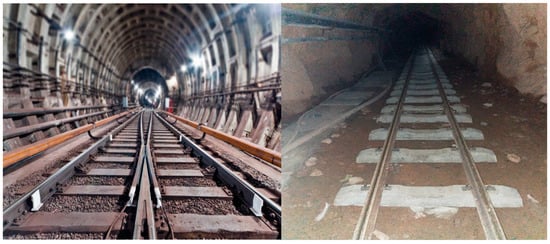
Figure 7.
Site map of the mining vehicle operating track.
Analysis of Forces on the Underground Mining Vehicle
To enhance our comprehension of the operational characteristics of underground mining vehicles equipped with regenerative braking systems on specific tracks, this study employed physical modeling and analyzed the forces exerted on the vehicle. The mining vehicle was dissected into intricate components, namely the chassis, track, body, electric motor, transmission system, and braking system. Detailed descriptions of the design features of the electric motor, transmission system, and braking system were provided. This encompassed explanations regarding the traction force produced by the electric motor, the transmission efficiency of the transmission system, and the structure of the braking system. Continuing the discussion of operational characteristics, the analysis focused on the forces acting on the vehicle during different operational scenarios, such as acceleration, deceleration, and braking. The effects of these forces on the vehicle’s performance were carefully examined, enabling a comprehensive understanding of the vehicle’s dynamics. Overall, by considering the various components and their interplay, this study aimed to shed light on the operational behavior of underground mining vehicles equipped with regenerative braking systems, ultimately contributing to the advancement of this technology in the mining industry.
As shown in Figure 8, the force analysis diagram of the mining vehicle indicates that during normal operation, the vehicle experiences traction force provided by the traction motor , frictional resistance between the wheels and the track , air resistance , gravitational force mg, and bearing friction . According to Newton’s second law,
where represents the sum of the traction forces exerted on the vehicle, represents the sum of the resistances, a represents the acceleration of the vehicle, unit: .
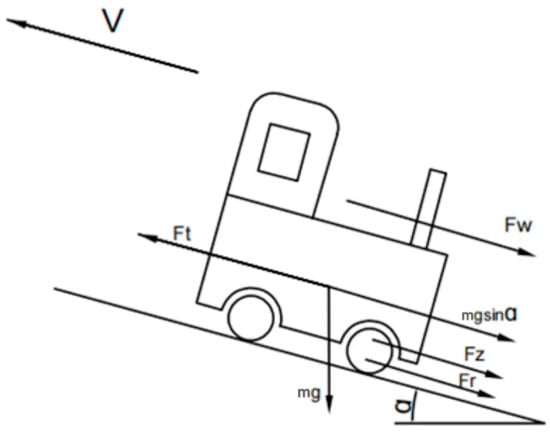
Figure 8.
Force analysis diagram of the underground mining vehicle.
Let us analyze the resistances experienced by the mining vehicle during its operation:
The main resistances acting on the mining vehicle while in motion consist of rolling resistance, air resistance, and uphill resistance.
- (1)
- Rolling resistance:
Since underground mining vehicles usually travel on specific tracks, the rolling resistance is generated from the friction between the vehicle’s wheels and the track. The rolling resistance experienced by the mining vehicle can be approximated as:
where is the road slope and is the rolling resistance coefficient.
The rolling resistance coefficient represents the rolling friction performance between the wheel and the rail. One common estimation method is to use an empirical formula for the rolling resistance coefficient:
where is the rolling radius, which can be estimated using the radius of the mining vehicle’s wheels.
- (2)
- Air resistance:
The resistance experienced by the mining vehicle is mainly composed of shape resistance and shell friction. It can be represented as:
where is the air density, is the frontal area of the vehicle, is the air resistance coefficient, and is the wind speed.
- (3)
- Uphill resistance:
Uphill resistance is a component of the parallel force to the gravitational force that occurs when the vehicle climbs a slope. Let us assume as a sign coefficient factor; = 1 when the vehicle is going uphill and = −1 when the vehicle is going downhill. It can be represented as:
- Calculation of Regenerative Braking Energy Recovery for Mining Vehicles
The motion equation of the mining vehicle during braking is given by:
where represents the braking force exerted on the vehicle, in units of N.
The calculation formula for the braking force is:
where μ is the coefficient of friction, generally taken as 0.3 in this paper, m is the mass of the underground mining vehicle, and g is the acceleration due to gravity.
When the underground mining vehicle is traveling on uphill or downhill sections of the track, the recoverable energy during braking can be calculated as:
where S represents the braking distance of the vehicle, h represents the height difference before and after braking, represents the velocity of the vehicle before braking, and represents the velocity of the vehicle after braking.
When the underground mining vehicle is traveling on a smooth section of the track, the gravitational potential energy component of the vehicle’s braking energy is nonexistent. Therefore, the recoverable energy during vehicle braking is given by:
At this time, the energy converted from the inertia of the vehicle during braking is mainly consumed by the vehicle’s friction losses and aerodynamic drag. The remaining energy can be recovered through energy storage devices.
The braking distance of the vehicle can be calculated using the following basic formula:
In the given context, a represents the deceleration of the braking system, F represents the braking force, and m represents the mass of the underground mining vehicle.
According to relevant coal mine regulations, when the length of a slope is less than 300 m, the maximum speed for transporting personnel or materials using mining vehicles is 3.5 m/s. When the length of a slope is greater than 300 m, the maximum speed is 5 m/s. The acceleration or deceleration for transporting personnel is 0.5 m/s2.
4. Simulation Modeling of Regenerative Braking Energy Recovery
ADVISOR2002 (Advanced Vehicle Simulator) is a sophisticated vehicle simulation software developed by the National Renewable Energy Laboratory (NREL) in the MATLAB R2014 and SIMULINK R2014 software environment. It enables rapid analysis of the fuel economy, power, and emission performance of conventional, pure electric, and hybrid vehicles using specific vehicle parameters under given road cycle conditions. The software also provides flexibility by allowing the simulation of user-defined vehicle models and strategies. In this paper, the ADVISOR tool is utilized to simulate an underground mining truck. The aim is to verify the changes in energy consumption resulting from the installation of a brake energy recovery device in the vehicle.
To begin, open MATLAB and input “advisor” in the MATLAB command line to launch the ADVISOR tool. Within the tool, select “New Vehicle” from the “File” menu to create a model of the underground mining vehicle. This can be based on an existing electric vehicle model. Then, import the parameters of the underground mining vehicle from Table 2 into the model. Configure the model by specifying vehicle parameters, powertrain specifications, battery characteristics, and other components. Select or create a suitable working condition that represents the underground environment to simulate vehicle performance under different driving conditions. Since brake energy recovery primarily occurs during braking, ensure that appropriate braking events are included in the defined road conditions. Next, configure the brake energy recovery system within the vehicle model. Define the parameters and performance of the braking system and designate the battery as the storage method for the recovered energy. Initiate the simulation of vehicle performance, including the evaluation of brake energy recovery, by selecting “Run Simulation” in the ADVISOR tool. Analyze the simulation results, specifically focusing on the impact of brake energy recovery. Based on these findings, make optimizations and adjustments to enhance the performance of the brake energy recovery system. By employing this systematic approach, the ADVISOR tool facilitates comprehensive analysis and improvement of the energy efficiency of the underground mining truck, thereby advancing the implementation of brake energy recovery technology in the mining industry.

Table 2.
CTY5/6GB explosion-proof motorcars.
Upon successful creation of the simulation model in ADVISOR, the drive train model of the underground mining vehicle can be exported, as depicted in Figure 9. This illustration visually represents the internal structure of the vehicle, showing how the power is directly supplied by the battery to the engine for propulsion. Furthermore, conducting cyclic operating conditions yields an energy consumption diagram, as shown in Figure 10. This diagram provides a comprehensive overview of the energy consumption patterns during the vehicle’s operation. By conducting a comparison calculation between the energy consumption generated by each component of the vehicle during the driving process and the energy consumption recovered by the vehicle, it becomes evident that the integration of braking energy recovery technology significantly reduces energy waste in the operations of the underground mining vehicle. This finding underscores the effectiveness of braking energy recovery in enhancing energy efficiency.
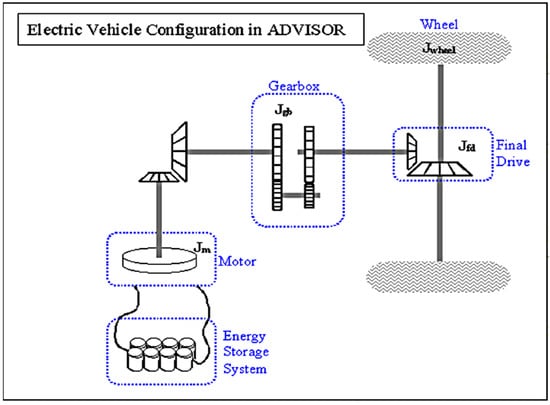
Figure 9.
Drive train model of the underground mine car.
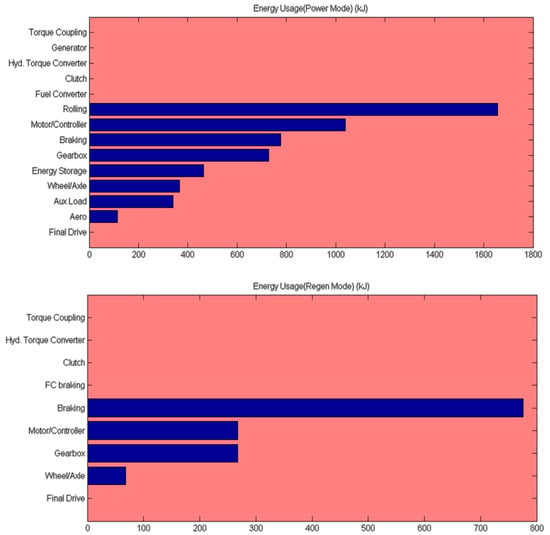
Figure 10.
The brake energy recovery underground mine train energy consumption map.
This paper presents the physical modeling and simulation of an underground mine car equipped with a brake energy recovery system. The results demonstrate the efficient recovery of approximately 60% of the braking energy after the installation of the regenerative braking device. This highlights the superior system design and significantly improves the energy utilization efficiency of underground mining vehicles. The successful capture and utilization of energy released during the braking phase, converted into electrical energy, provides the mining vehicle with additional driving force. This innovative design greatly enhances the energy recovery capability of underground mining vehicles, resulting in more sustainable and efficient power support for their operations. Furthermore, the introduction of this technology has significantly extended the range of underground mining vehicles. Simulation calculations indicate that the installation of the regenerative braking device increases the vehicle’s range by approximately 20%. This implies that the mining vehicle can travel a longer distance with the same energy reserve, reducing the need for frequent energy replenishment, improving transportation efficiency, and reducing reliance on energy resources. To summarize, this study makes significant contributions to enhancing the energy efficiency of underground mining vehicles. The application of this technology not only promotes environmental protection and energy conservation but also enhances the performance and economic benefits of underground mining vehicles in practical operations.
5. Conclusions and Prospects
This paper focuses on the optimization of the underground mine car design, specifically using the CTY5/6GB explosion-proof motor car as the research object. Physical modeling and simulation are employed to comprehensively consider the operating environment, load requirements, and braking system performance. These techniques provide an in-depth understanding of the behavior of underground mine cars under different conditions and serve as a valuable foundation for subsequent experiments and applications. The implementation of regenerative braking technology in mining vehicles offers several advantages. Firstly, it effectively recovers energy losses during the braking process, reducing reliance on external systems and enhancing energy utilization efficiency and system operation efficiency.
Secondly, it reduces heat generation in the braking system, thereby extending its service life.
Thirdly, this technology contributes to the reduction of energy consumption and CO2 emissions in the coal mine transportation system, facilitating energy-saving measures and compliance with environmental regulations.
Experimental results demonstrate the feasibility of applying regenerative braking technology in mining vehicles, with a recovery rate of approximately 60%. This technology provides reliable and cost-effective solutions for various types of coal mine transportation systems. It offers substantial economic and environmental benefits, making it an efficient and feasible solution for energy saving and emission reduction in the mining vehicle sector. Furthermore, its potential for optimization and wide application in mining vehicle energy consumption warrants further exploration.
The study of optimal underground mine car design with a focus on brake energy recovery systems is crucial for improving energy efficiency and reducing environmental impact. With the increased emphasis on renewable energy and energy sustainability, this technology is expected to find widespread application and further development in the future. The application of Brake Energy Recovery Systems (BERS) significantly minimizes adverse environmental impacts by reducing reliance on external power sources and mitigating waste heat and CO2 emissions from mining vehicle operations. This sustainable technological innovation aligns well with the mining industry’s environmental impact. Although the initial investment may be substantial, the installation of brake energy recovery systems is expected to yield long-term benefits as energy prices rise and the demand for sustainable mining practices increases. Companies can anticipate financial gains through improved energy efficiency, reduced energy consumption, and decreased environmental impact. As global attention to environmental protection and sustainability continues to grow, it is likely that more regulations and policies will emerge to encourage the mining industry’s adoption of environmentally friendly and energy-efficient technologies. Brake energy recovery systems may become a recommended technology to meet regulatory and policy requirements, prompting more companies to embrace this solution. In conclusion, the investigation into the installation of brake energy recovery systems in underground mining vehicles represents a forward-looking and sustainable endeavor. It not only brings more efficient, cost-effective, and environmentally friendly solutions to the mining vehicle industry but also promotes sustainable development across the sector as a whole.
Author Contributions
Conceptualization, J.H. and P.L.; methodology, J.H.; validation, J.H., P.L. and H.H.; formal analysis, P.L.; resources, J.H.; data curation, X.L.; writing—original draft preparation, P.L.; writing—review and editing, P.L. and B.M.; visualization, B.M.; supervision, X.L.; project administration, H.H.; funding acquisition, J.H. All authors have read and agreed to the published version of the manuscript.
Funding
This research was funded by the National Natural Science Foundation of China, grant number 52174121.
Institutional Review Board Statement
Not applicable.
Informed Consent Statement
Not applicable.
Data Availability Statement
The data presented in this study are available on request from the corresponding author. The data are not publicly available due to privacy.
Conflicts of Interest
The authors declare no conflict of interest.
References
- Wo, X.; Li, G.; Sun, Y.; Li, J.; Yang, S.; Hao, H. The Changing Tendency and Association Analysis of Intelligent Coal Mines in China: A Policy Text Mining Study. Sustainability 2022, 14, 11650. [Google Scholar] [CrossRef]
- Liu, X.; Li, L.; Yang, Y. Development status of coal mining in China. J. S. Afr. Inst. Min. Metall. 2023, 123, 19–27. [Google Scholar] [CrossRef]
- Efremenkov, A.B.; Khoreshok, A.A.; Zhironkin, S.A.; Myaskov, A.V. Coal Mining Machinery Development As An Ecological Factor Of Progressive Technologies Implementation. In Proceedings of the Conference on Ecology and Safety in the Technosphere—Current Problems and Solutions, Yurga, Russia, 17–19 November 2016. [Google Scholar]
- Wu, X.; Li, H.; Wang, B.; Zhu, M. Review on Improvements to the Safety Level of Coal Mines by Applying Intelligent Coal Mining. Sustainability 2022, 14, 16400. [Google Scholar] [CrossRef]
- Zhao, S.; Chen, X.; Zhao, X. Analysis of Current Status and Development Direction of Coal Mining Technology in China. In Proceedings of the 4th International Conference on Energy Science and Applied Technology (ESAT), Chongqing, China, 29–30 December 2018. [Google Scholar]
- Hong, C. Vertical coupling vibration analysis of underground mine car-track based on computer simulation. Coal Technol. 2014, 33, 20–22. [Google Scholar] [CrossRef]
- He, H. Based on the analysis of the way to improve the maintenance efficiency of underground mine cars in coal mines. Inn. Mong. Coal Econ. 2020, 127+129. [Google Scholar] [CrossRef]
- Zuo, H. Design and application of automatic re-tracker for underground coal mine trucks. Small Medium-Sized Enterp. Manag. Technol. Low. 2014, 133–134. [Google Scholar]
- Wang, Y.; Chen, J.; Liu, J.; Liu, K.; Zhang, Y.; Wu, J.; Zeng, H.; Guan, Z.-L. Research and Implementation of Key Technology of Braking Energy Recovery System for Off-Highway Dump Truck. In Proceedings of the 43rd Annual Conference of the IEEE-Industrial-Electronics-Society (IECON), Beijing, China, 29 October–1 November 2017; pp. 3912–3917. [Google Scholar]
- Wang, Y.; Yang, W.; Yang, Y.; Zhang, W. Parameter matching of composite power supply for mining vehicle oriented by maximising braking energy recovery. Int. J. Heavy Veh. Syst. 2023, 30, 476–499. [Google Scholar] [CrossRef]
- Wang, Y.; Yang, W.; Zhang, W. Research on the braking energy reuse management strategy of hybrid electric mining trucks based on motor load rate. Proc. Inst. Mech. Eng. Part D-J. Automob. Eng. 2023. [Google Scholar] [CrossRef]
- Pielecha, I.; Cieslik, W.; Szalek, A. Energy recovery potential through regenerative braking for a hybrid electric vehicle in a urban conditions. In Proceedings of the 2nd International Conference on the Sustainable Energy and Environmental Development (SEED), Krakow, Poland, 14–17 November 2017. [Google Scholar]
- Zheng, L.; Shi, Z.; Luo, Y.; Kang, J. A Study of Energy Recovery System during Braking for Electric Vehicle. In Proceedings of the 6th International Conference on Applied Science, Engineering and Technology (ICASET), Qingdao, China, 29–30 May 2016; pp. 8–13. [Google Scholar]
- Xu, Z.-q. Research on Vehicle Braking Energy Recovery System and Energy Recovery Calculation. In Proceedings of the International Conference on Computational Science and Engineering (ICCSE), Qingdao, China, 20–21 July 2016; pp. 33–36. [Google Scholar]
- Han, T.; Zeng, B.; Tong, Y. Theoretical study on energy recovery rate of regenerative braking for hybrid mining trucks with different parameters. J. Energy Storage 2021, 42, 103127. [Google Scholar] [CrossRef]
- Xiong, Y.; Yu, Q.; Yan, S.; Liu, X. An Innovative Design of Decoupled Regenerative Braking System for Electric City Bus Based on Chinese Typical Urban Driving Cycle. Math. Probl. Eng. 2020, 2020, 8149383. [Google Scholar] [CrossRef]
- Ma, Z.; Sun, D. Energy Recovery Strategy Based on Ideal Braking Force Distribution for Regenerative Braking System of a Four-Wheel Drive Electric Vehicle. IEEE Access 2020, 8, 136234–136242. [Google Scholar] [CrossRef]
- Ji, F.; Pan, Y.; Zhou, Y.; Du, F.; Zhang, Q.; Li, G. Energy recovery based on pedal situation for regenerative braking system of electric vehicle. Veh. Syst. Dyn. 2020, 58, 144–173. [Google Scholar] [CrossRef]
- Geng, C.; Ning, D.; Guo, L.; Xue, Q.; Mei, S. Simulation Research on Regenerative Braking Control Strategy of Hybrid Electric Vehicle. Energies 2021, 14, 2202. [Google Scholar] [CrossRef]
- Duong, T.T.; Van Do, D.; Nguyen, T.T. Research on Braking Force Distribution in Regenerative Braking System Apply to Conventional Vehicle. In Proceedings of the 4th International Conference on Green Technology and Sustainable Development (GTSD), Ho Chi Minh City, Vietnam, 23–24 November 2018; pp. 48–52. [Google Scholar]
- Spichartz, P.; Sourkounis, C. Assessment of Recuperation Strategies for Electric Vehicles by Simulations and Measurements. In Proceedings of the International Symposium on Power Electronics Electrical Drives, Automation, and Motion (SPEEDAM), Anacapri, Italy, 22–24 June 2016; pp. 1226–1231. [Google Scholar]
Disclaimer/Publisher’s Note: The statements, opinions and data contained in all publications are solely those of the individual author(s) and contributor(s) and not of MDPI and/or the editor(s). MDPI and/or the editor(s) disclaim responsibility for any injury to people or property resulting from any ideas, methods, instructions or products referred to in the content. |
© 2024 by the authors. Licensee MDPI, Basel, Switzerland. This article is an open access article distributed under the terms and conditions of the Creative Commons Attribution (CC BY) license (https://creativecommons.org/licenses/by/4.0/).